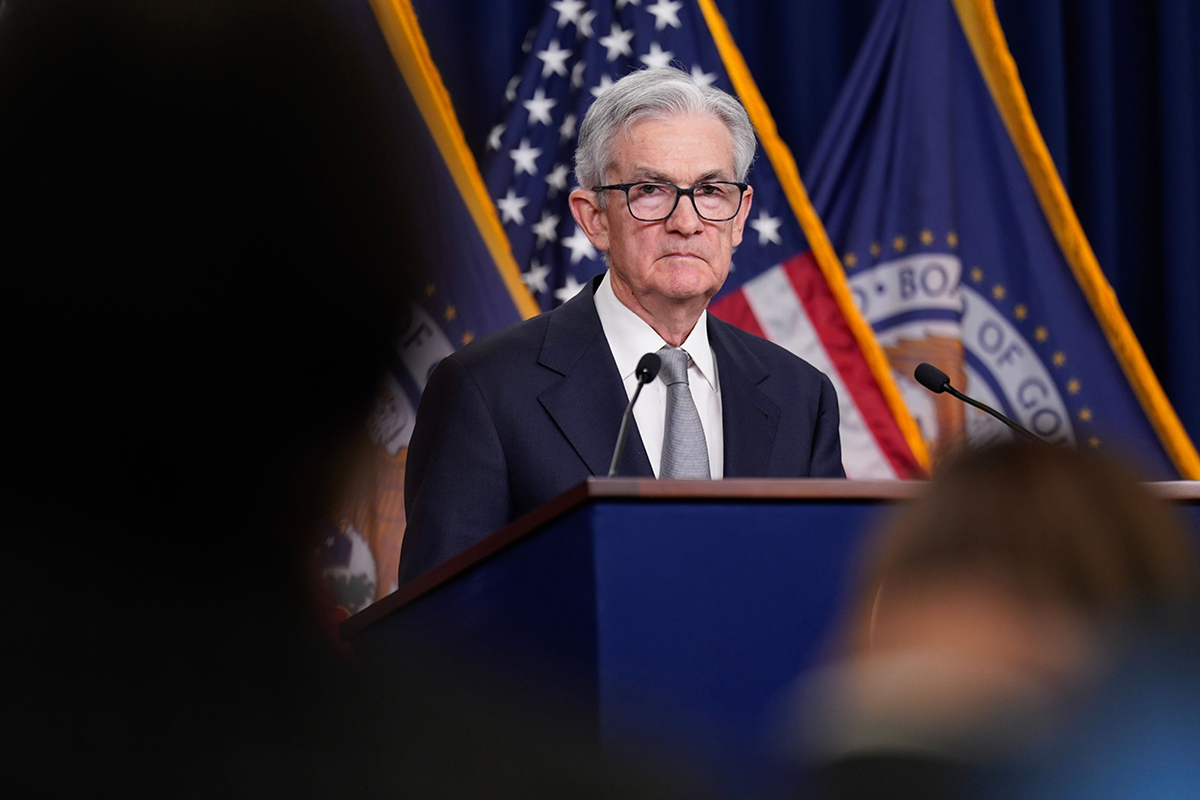 Jerome Powell, chairman of the U.S. Federal Reserve, during a news conference on November 1, 2023. Photographer: Al Drago/Bloomberg
Jerome Powell, chairman of the U.S. Federal Reserve, during a news conference on November 1, 2023. Photographer: Al Drago/Bloomberg
Federal Reserve officials cemented the end of their aggressive campaign to push up interest rates, and sought to reset expectations for how soon and how fast they'll cut this year as inflation pressures fade.
While policymakers are shifting their focus to when to start easing policy amid a favorable pullback in inflation, it's clear they're in no rush to lower rates. Against a backdrop of a still-solid economy, Chair Jerome Powell said officials would move patiently and doused speculation that rate cuts would start at the next meeting.
Recommended For You
"We're not declaring victory at all," Powell told reporters Wednesday following the Fed's policy meeting, emphasizing the need to see "more" data confirming a sustained downward trend in inflation. "I don't think it's likely that the committee will reach a level of confidence by the time of the March meeting.
"It's a highly consequential decision to start the process of dialing back on restriction, and we want to get that right," Powell added.
Market odds for a rate reduction in March, which had risen above 50 percent in recent days, dropped to close to one-in-three following Powell's press conference. The S&P 500 slid by 1.6 percent Wednesday, and Treasury yields remained lower.
"The messaging is pushing back against complacently assuming the FOMC [Federal Open Market Committee] will cut in March," said Derek Tang, an economist with LH Meyer/Monetary Policy Analytics. "Data dependency is still the calling card."
The FOMC voted unanimously to leave the benchmark rate unchanged at a 22-year high—as expected—in a target range of 5.25 percent to 5.5 percent for a fourth straight meeting.
Officials revamped the post-meeting statement, dropping a reference to a possible additional "firming" of policy and indicating that it wouldn't be appropriate for the Fed to cut rates "until it has gained greater confidence that inflation is moving sustainably toward 2 percent."
Powell repeated those words and pushed back against market expectations for five or six rate cuts this year, saying, "We are prepared to maintain the current target range for the federal funds rate for longer, if appropriate."
What Bloomberg Economists Say
"Powell's statement at the news conference that—given the current data—a March cut is unlikely lowers the odds of a move at the next meeting. That said, we expect [that] continued soft inflation data and weaker labor-market data ultimately will allow officials to gain enough confidence to move in March—which remains our base case."
— Anna Wong, Estelle Ou & Stuart Paul
"The Fed feels confident it can wait a while longer before initiating a rate-cutting cycle," said Kathy Jones, Charles Schwab's chief fixed-income strategist. "There is clearly a concern about making a policy mistake."
Ongoing Inflation Concerns
Among the central bank's concerns is an upward revision to inflation figures. The revised figures for the consumer price index (CPI)—a closely watched price gauge—set to be released in February could reverse some of the recent improvement from late 2023.
The Fed's preferred gauge of underlying inflation cooled to an almost three-year low in December. Excluding volatile food and energy, the metric was up 1.9 percent in December on a six-month annualized basis, trailing the Fed's 2 percent target for a second month.
Powell also made it clear that with the economy holding up well in 2023 and the labor market staying strong, he is no longer expecting that significant weakness—which he had called "pain" in the past—is needed to bring down prices. At the same time, unexpected weakness in the labor market would affect the pace and timing of rate cutting, he said.
"There is a concern that much of the low-hanging fruit on disinflation has been plucked," said Diane Swonk, chief economist at KPMG LLP. "The economy is strong enough to hedge against committing the cardinal sin of central banking, which is to cut and have to reverse course and hike again."
The central bank reiterated its intention to continue reducing its portfolio of assets by as much as $95 billion per month, but Powell said Fed officials plan to start in-depth talks about the balance sheet at their March meeting.
The balance sheet discussions "will stretch out for a quite a while," said Lou Crandall, chief economist at Wrightson ICAP. He sees the Fed making a decision in June to begin tapering in July.
© Touchpoint Markets, All Rights Reserved. Request academic re-use from www.copyright.com. All other uses, submit a request to [email protected]. For more inforrmation visit Asset & Logo Licensing.



